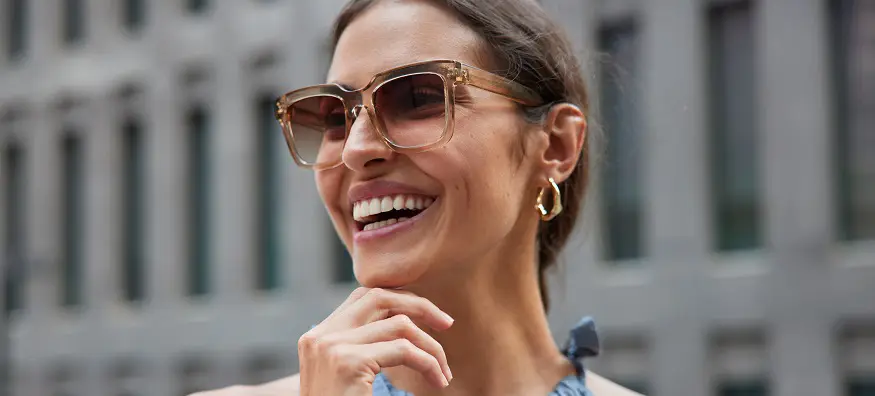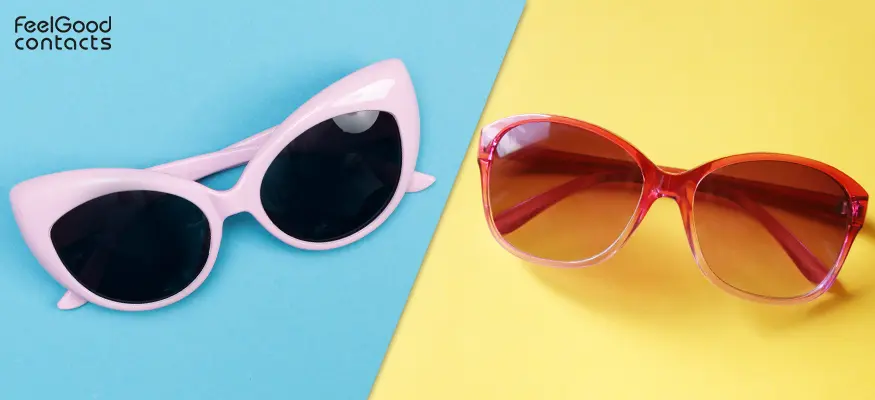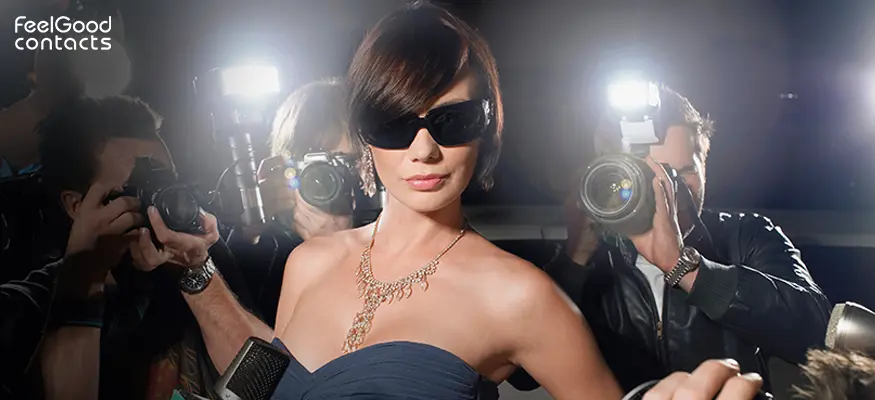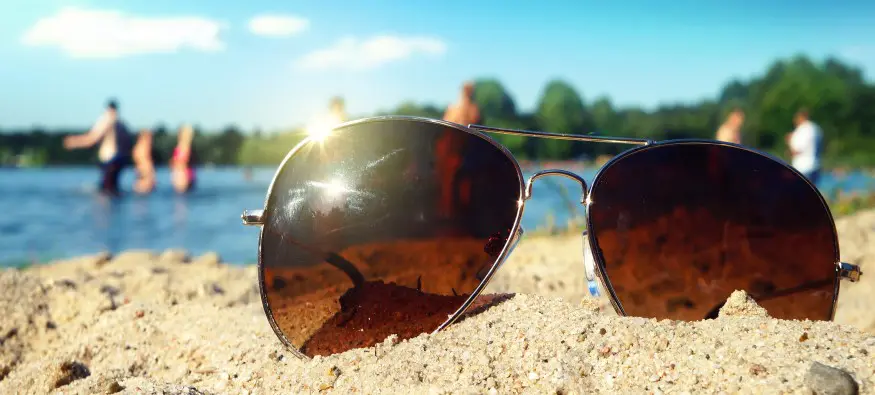The EU Intellectual Property Office (EUIPO) and Taxation and Customs Union (DG TAXUD) have published their annual report stating that 86 million counterfeit articles had been seized in 2022 with an estimated value of more than €2 billion. The authorities said that huge numbers of counterfeit sunglasses, watches, clothing, bags, wallets and more were seized.
Feel Good Contacts partnered with The Anti-Counterfeiting Group (ACG), the voice of business in shaping an effective deterrent to counterfeiting in the UK, to warn the public of the dangers of purchasing counterfeit sunglasses.
Since 1980, the ACG has aimed to help steer effective policy, promote evidenced-based actions, empower multi-agency partnerships and strengthen international collaboration to end counterfeit activity in the UK.
Why is wearing fake sunglasses a problem?
Fake sunglasses pose a very immediate danger. While quality, branded sunglasses meet strict safety standards, fakes don’t, and because of this, they do not block UV light from reaching our eyes. They can allow more UV light into the back of the eyes than exposure to the naked eye. Therefore, fake sunglasses can actually cause more damage to the eyes than not wearing any sunglasses at all.
Wut Win, Dispensing Optician at Feel Good Contacts, says:
“UV rays from the sun can cause significant damage, which can result in sight loss. It’s commonly known that sunglasses help people see better in bright light, and the price tag on fake sunglasses can make them a tempting option. However, unsuspecting bargain shoppers don’t always realise that the cheap glasses they’re buying offer little or no protection against UV rays.”
The World Health Organisation estimates that at least 2.2 billion people have near or distance vision impairment or blindness, or enhanced by exposure to the sun specifically. Other serious conditions can also be caused by direct and prolonged exposure to the sun, such as age-related macular degeneration and glaucoma.
Solar UV rays that can damage our skin are most intense during midday in summer. The closer we get to the equator, the stronger the UV rays become. Environmental factors like sandy terrains also increase our exposure to harmful rays. Our eyes are particularly vulnerable to damage from UV rays reflected off sandy surfaces.
Phil Lewis, Director General at The Anti-Counterfeiting Group (ACG) says:
“Buying fake sunglasses may seem like a harmless whim, but it has wider implications. Most fakes come from Southeast Asia and are made in sweatshop factories with exploited workers, including children. The UK market for counterfeit goods is worth billions, with a stupendous amount in unpaid tax. This leads to job losses and the threat of criminals entering our lives. For these reasons, we are urging the public to report any instances of fraud.”
How can I spot fake sunglasses?
In the UK, sunglasses sold in the region must meet rigorous safety standards. Fake sunglasses do not meet these standards and are unlikely to block harmful UV rays from reaching our eyes.
Consumers must check that their glasses meet the British Standard for sunglasses (BS EN ISO 12312-1:2022). Also, look out for the CE mark (which indicates that manufacturing processes comply with European quality standards) or UKCA mark (which indicates compliance with standards in the UK) printed on the sunglasses. All sunglasses sold legally in the UK will have this mark.
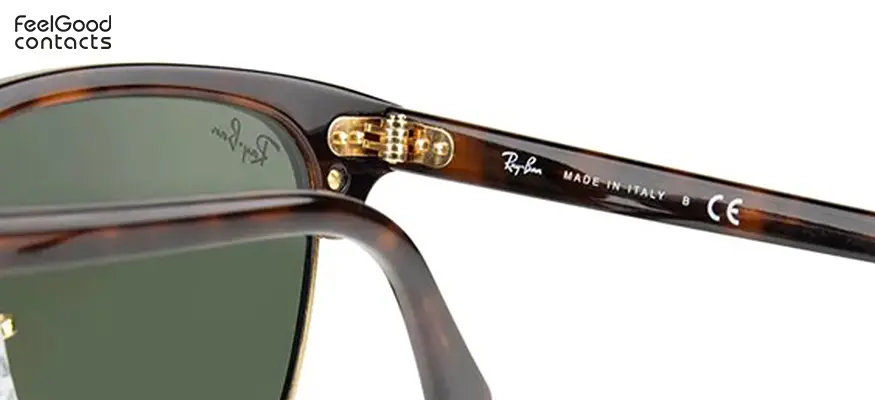
Fake sunglasses can have missing or wrong information. To avoid being mis-sold, look on the inside of the arms. Is the brand name, model number, and colour code there? If so, it shouldn’t scratch off easily, a common trait of counterfeit glasses.
Sometimes, it’s not as easy to spot a replica. In this case, the only distinguishable feature is the price. If it’s a little too good to be true, it’s best not to risk it.
What to look out for in fake sunglasses?
You should expect exceptional quality from genuine sunglasses from designer brands. Look for high-quality materials, excellent construction and attention to detail, from a neat finish around the hinges to the weight and texture of the material.
1. Quality
You can test the quality of the craftsmanship by feeling the arms of the glass frames with your fingers. If the acetate or metal feels jagged or rough, they are likely not to have been made by the designer brand they claim to be.
2. Hinges
Designer-quality sunglasses will have hinges made of solid metal, which should be securely bolted to the frame using metal rivets. Look out for two at the front and two at the side. Hinges on fake models will not be as neatly fixed onto the frame. Traces of glue or melted plastic may also be visible if they are fake.
3. Nose pads
Real designer glasses will have good quality adjustable nose pads that do not move around easily but are not easily snapped. If the model has a fixed nose pad, it should be smooth, with no rough patches or lumps.
4. Sun lenses
An authentic pair of designer sunglasses should have the correct brand logo printed on the lens, usually on the temporal side. This is a key indicator of authenticity as it is expensive and difficult for fraudsters to replicate.
How can I protect my eyes from sun damage?
Good-quality sunglasses bought through legal channels provide the best protection from UV light. Sunglasses should always be purchased from reputable dealers, as this is the only guarantee that customers will get the sun protection they need.
Feel Good Contacts is an official distributor of major sunglasses brands such as Ray-Ban, Polaroid, and many more. We offer authentic designer brands at affordable prices and hold accounts with Luxottica, Marchon, and Safilo. Our stock is 100% genuine, as we do not source from third-party sellers. We also create our own Feel Good Collection using the latest technology and high-quality materials.
Types of UV rays
UV radiation is the central element of solar radiation. There are three types of UV rays: UVA, UVB and UVC.
UVC rays are the most damaging, but they are absorbed by the earth’s atmosphere before they reach us and are not a direct threat. Meanwhile, UVA and UVB rays can have serious long-term and short-term effects on the eyes and vision.
Most common eye problems caused by UV rays
UV rays of the sun can cause several eye problems, such as:
1. Age-related macular degeneration (AMD)
The leading cause of age-related macular degeneration is the direct result of prolonged damage to the retina. While the condition affects your central vision and what you can see when you look straight ahead, it generally does not affect your peripheral vision or lead to complete blindness. Sight loss is mostly gradual but can happen more rapidly in some instances.
2. Cataracts
Cataracts are progressive clouding of the eye’s natural lens and core focusing mechanism. UVB rays increase the risk of developing certain cataracts, which can be treated with surgery.
3. Pterygium
Often called surfer’s eye, pterygium is a non-cancerous, often fleshy-coloured growth that forms on the layer of the conjunctiva over the white area (sclera) of your eye and can invade the cornea. As UV light is believed to be a main factor in forming these growths, it is commonly linked to surfers who spend long periods in the sun and are subjected to direct and reflected UV rays. However, that does not mean that non-surfers cannot develop pterygium.
4. Photokeratitis
Also known as corneal sunburn or snow blindness, photokeratitis results from prolonged exposure to UVB rays.
Disclaimer: The advice and suggestions in this blog are for informational purposes only and are not a substitute for medical care. Before trying any products or remedies, consult with an eye care professional. See our Editorial Policy for details on how we review our blog.

















